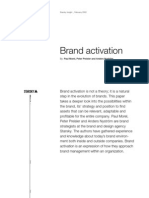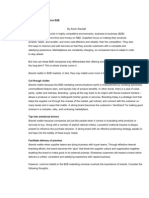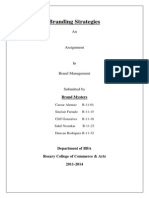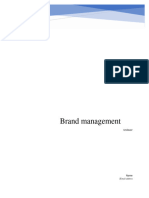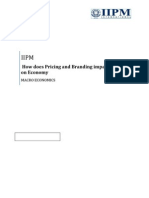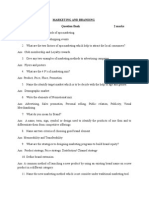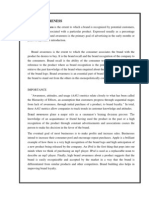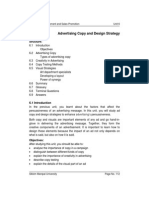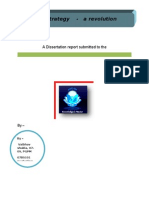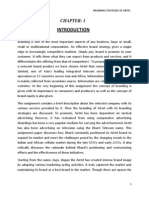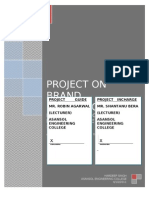The Marketing Mix and Building A Brand
The Marketing Mix and Building A Brand
Uploaded by
Shanmuga PriyaCopyright:
Available Formats
The Marketing Mix and Building A Brand
The Marketing Mix and Building A Brand
Uploaded by
Shanmuga PriyaOriginal Description:
Original Title
Copyright
Available Formats
Share this document
Did you find this document useful?
Is this content inappropriate?
Copyright:
Available Formats
The Marketing Mix and Building A Brand
The Marketing Mix and Building A Brand
Uploaded by
Shanmuga PriyaCopyright:
Available Formats
Chapter 9 The Marketing Mix And Building A Brand
CHAPTER 9
THE MARKETING MIX AND BUILDING A BRAND
Brand promotion
This chapter is about building a brand by using tools from the marketing kit bag. In industrial and business to business markets the brand is often an umbrella that covers a large product range and quite often is the company name as well. In these cases building a brand cannot be separated from building the company. In a small and embryonic company it is understandable that there is an emphasis on selling over marketing. Selling is usually more tactical and brings in immediate life blood to a company whereas marketing is more strategic and sets the scene for the longer term. With only a little thought and a coordinated approach, industrial companies can build a stronger brand and ultimately win more sales, achieve more loyal customers, and all this at better prices. Another general point is that most promotions have an objective other than building the brand. They may be designed to inform, excite, interest and they may to persuade people to pick up the phone. Most promotions are a mixture of both brand building and product selling. In earlier chapters we defined how branding is achieved through building awareness, differentiating, communicating positive perceptions of the brand and adding value. Brand promotion is carried out for these reasons. Brands exist because they are communicated. Brand promotion is concerned with the active and positive
Page 97
The Power Of Industrial Brands
communication of the brand and its values. However, brands are communicated in other and crucially important ways. The purchase of a product is perhaps by far the most important form of brand communication. So are delivery and the service that backs up the products. Good experiences in these areas will enhance the brand as it will lead to it being viewed positively and acquiring the right sort of values. Equally a bad experience of the product or the service will have a negative impact on the brand and these deficiencies will be difficult or impossible to correct through promotion. Promotion, therefore, cannot be thought of in isolation, nor can it alone build and sustain a brand - in the end any promise has to be fulfilled.
Branding promotion methods
There are nine different types of promotions that can be used for brand building. These are:
Web site Promotional literature Packaging Company signs and livery Direct mail Media advertising Public relations Personal contact Exhibitions Lets have a look at them in more detail.
Web site
The promotional budgets of most business to business and industrial companies are modest compared to those of their consumer cousins. If the total budget for the year is less than 100,000, there is a limit to what can be achieved on the television assuming that the medium reached the target audience. However, a website can be set up for next to nothing and a 10,000 budget would buy you something that was all singing and dancing. The web site has become the new promotional literature giving more space and flexibility to describe the products, more opportunity for a small company to appear large, and the ability to constantly keep it up-todate. Therefore it shouldnt come as any great surprise to learn that in a recent survey, 25% of industrial and business to business companies said that their websites are the most important method of promotion. This was way ahead of all the other forms of promotion.
Page 98
Chapter 9 The Marketing Mix And Building A Brand
Promotional literature
Promotional literature in this context includes everything from stationery and business cards through to brochures, news letters, data sheets and price lists. Every company needs these basics and for some industrial firms they are an important aid to personal selling. As companies grow, the array of promotional literature expands and it may not be long before there is a potpourri of styles. Odd pieces of literature are generated for a specific purpose but do not fit with the rest of the house style. Even in the largest corporates with strict rules on branding and house styles, staff are allowed to devise their own signatures for e-mails. Given that e-mail is by far the largest means of written communication today, it is amazing that there is little control over the templates that are used. The design and contents of every piece of literature and print should be carefully thought through and in particular in relation to its projection of the brand as well as a vehicle for product data. For example, what does a picture of the factory really achieve and would it be better to talk about the benefits of the product and not to assume that everyone already knows them. As with all the elements of the marketing mix, it is better to have a limited range of good material than stacks of the mediocre. Consistency is also important. The material should recognisably hang together with a consistent use of the brand logo.
Packaging
In consumer markets the product and its packaging is a very important tool in not only selling the product (eg off the supermarket shelf) but also in communicating brand values. How the packaging is presented has an important influence on the perceptions of the brand. In most industrial and business to business markets, the products and their packaging are not seen as brand communication vehicles. Sometimes this reflects the nature of the product as is the case in bulk raw materials where there is no opportunity to place a branding mark (though we shall show below that the livery of the vehicles which carry the products form valuable branding opportunities for companies operating their own transport fleet). In other industrial markets there is often the possibility of branding the packaging but it is overlooked. For very little cost, packaging could be designed to communicate brand values. By way of example, a supplier of test sieves used in geological analysis, despatched his products in a plain cardboard box. A new and high quality carton was designed with a brief to emphasise the quality and accuracy of the sieve. A test certificate was also included. Not only did this lead to a rapid increase in sales but in a year or two the brand dominated its market, despite price rises against competitors, because of the added value from the packaging. This innovative approach to packaging need not be restricted to manufacturers of precision instruments. For an insurance company or a supplier of capital plant, packaging may not be a cardboard box but the presentation of the quotation. The clarity of the submission, the standard of printing, the use of diagrams and
Page 99
The Power Of Industrial Brands
the way it is bound will all influence the perceptions of the product before it is sampled.
Company signs and livery
Signs outside the company and in the offices or factory are an important branding opportunity and create a first impression for all visitors. Employees are welded together by the brand and it isnt out of the ordinary to see staff wearing a company polo shirt resplendent with logo, as they walk around the shops at the weekend. Bank managers and suppliers notice signs and it shapes their perception of the company. This is not to say that every company should promote itself in neon lights. A sign which shouts out loud may be acceptable for a manufacturer of toys but something more subtle is more appropriate for a professional firm. As with all aspects of branding, control is needed to at least avoid any negative effects which could arise from dilapidated or dirty signs. Surely this would signal a run-down or lackadaisical company; the very opposite of what should be intended. A chemical company carried out market research amongst its customers which showed that it was rated highly in all critical aspects, especially in quality which was one of the most important factors driving the buying decision. The company ran its own fleet of vehicles which, in research, proved to be the most visible aspects of the brand. The well maintained fleet with its attractive livery delivered to some large customers two or three times a day. In its wisdom, the company outsourced the delivery and the liveried vehicles were replaced by those of contract hauliers. Gone was the positive image and gone was the brand reinforcement. A few pounds were saved in transport and a fortune was lost in goodwill. In only a matter of years the company was taken over by its larger German rival.
Direct mail
For many industrial and business to business companies, direct mail is a very effective tool for both creating awareness of the brand and communicating positive values. Of course, much of it is "wasted" going straight in the bin but this is to be expected in a medium which only hopes to attract serious attention from a small percentage of recipients. If 2% of people took action as a result of a direct mail campaign, it could be deemed successful and pay for itself. What is more its results are entirely measurable which is more than can be said for
Page 100
Chapter 9 The Marketing Mix And Building A Brand
some of the other forms of promotion. We are entering an interesting phase in direct promotions. We live in an age of multimedia, with more options for promotions than ever before. Every company is at it and so the promotional noise is horrific. In this cacophony, our attempts to be heard fail far more often than they succeed and to the observer it seems like a huge waste of energy and money. One such area is e-marketing using the Internet for targeted email campaigns. However, such as the ease with which these campaigns can be fired off that every Tom Dick and Harry is using it to sell everything from sex potions to dodgy credit. Direct marketing used to be the darling of industrial marketers, but today both the paper and e-versions have sunk in popularity.
Media advertising
Media advertising plays a huge role in brand building. Through carefully positioned adverts with images that can reach the conscious and subconscious, a brand position can be manipulated. Potentially, industrial marketing could include the national press in its media schedule but this is generally far too expensive and inappropriate for industrial companies supplying niche markets. Use of the nationals is restricted to the largest of firms and those supplying widespread business-to-business markets. Far more typically, industrial companies place adverts in trade journals and directories specific to their industry. The quality of the advertising in these trade journals and directories is still difficult to match with the adverts in consumer magazines. Partly this is a matter of money as tiny budgets leave little for classy design. However, the problem also stems from the inadequate imagination and commitment of managers. Working on a limited budget, it is always better to produce a really good media campaign and run it in one trade journal than place poor material more widely. At least this approach has the possibility of the campaign achieving some impact whereas the `spread it thin' tactic means that no one will taste it.
Public relations
Public relations cover press releases, customer events and videos. The aim is not to win immediate sales but to build an awareness of the company and to shape its image. Public relations can be a cost effective method of promotion. At its crudest, all it requires is a letterhead, a story and a list of journals and media who may be interested in picking it up. Industrial companies fall into one of three classes in their use of PR. There are those who ignore the use of PR completely, either over-looking it as a marketing tool or not realising what it can achieve. There are those who do PR badly, usually attempting it themselves, because it is so temptingly inexpensive and ostensibly so easy to carry out. And finally there are those who carry it out well, in the main using the services of a public relations professional.
Page 101
The Power Of Industrial Brands
The biggest problem with most industrial PR programmes is the lack of control over what will be picked up and used within the press. Whereas there is tight control over the design and location of media advertising, the effect of PR is more haphazard. When it works well it is highly effective as a story written by a journalist is seen to be more credible than a story told in an advert.
Personal contact
Most industrial products are sold through personal selling. Personal selling covers face to face meetings through to telemarketing. In the same way that PR is powerful but difficult to control, so too is personal contact. It is therefore an important weapon in the branding armoury but it is one that needs careful management. We can go to considerable trouble designing a logo for the brand and ensuring that it is always used correctly. However, the impression left by the salesman who calls or presents himself at a customers offices will, without a doubt, have a huge impact on the customers perceptions of a company and its brand. Personal contact extends beyond the sales function to all staff with any sort of public interface. The first point of contact with customers is the reception. We all know the effect on the brand of a garbled statement of the company name, a disinterested voice, or an unanswered phone.
Exhibitions and trade shows
Every industry has its exhibitions and trade shows. They work best wherever there is a product to show and so they are perfect for manufacturers of food machinery or machine tools. They work for companies that want to demonstrate technological innovations. They also are favoured by companies selling high value products or services as ust one or two orders will cover the high cost of exhibiting.
Promotional planning
We have seen that there are a variety of different types of promotions that can be used for brand building and so the industrial company with a modest budget is going to have to plan carefully. There must be clear objectives for the promotion. Careful consideration is needed for the optimum mix of promotional methods and care is needed in getting the right values into the creative execution of the adverts. Some aspects of promotion planning are as follows. Budgeting. The achievements and objectives of the promotional plan will largely be determined by the available budget. By the standards of consumer markets, industrial promotion budgets are generally small if not minute and as is argued elsewhere, the limited promotion budget to back branding is an argument against subbranding which requires support for each specific brand name used in conjunction with the main brand.
Page 102
Chapter 9 The Marketing Mix And Building A Brand
Small budgets can produce results if they are focused and not dissipated. Setting the budget will inevitably be some sort of compromise between what is sought as a marketing objective and what is judged affordable, with usually the greater pressure from the latter. The marketing manager therefore has to juggle the budget as best he or she can with what is set aside. Objectives setting. This is the key to effective brand promotion and it requires the marketing manager to decide what promotions are meant to achieve in terms of awareness building and brand value communications. If there are several core brand values, which have priority? There is also targeting to consider; what are the priorities in terms of market sectors and niches? This includes, in some markets, decisions about reaching the various levels of the market (eg in the construction market this may include specifiers, installers, buyers, users and distributors). Targeting may also include deciding which brand values to stress in each sector. Promotion methods. The choice of effective promotional methods depends on the target; the groups of people to whom the company wants to communicate. If the target market is a few dozen companies scattered worldwide, the method will be very different from one where there are hundreds of small businesses scattered in every locality. Professional assistance from advertising agencies may be sought at this stage - their suggestions at least, usually cost nothing. Most types of promotions will be used for purposes unrelated to branding and this includes the salesforce whose principal role in life will be to bring in business. Thought should be given to how any unintended as well as planned effects on brand perceptions can be controlled throughout the marketing mix. Design of promotion material. The importance of the design of promotional material has already been stressed. It needs the company to be committed to quality and to choosing the best designers that can be afforded. Administration. Administering the promotional budget is a matter of making sure it all happens, that the staff and resources are in place to ensure this and that the promotions are working towards the key goals. Some parts of the marketing mix need special attention as they are susceptible to slippage. In direct mail, for example, a sound plan of mailings may be developed at the start of the year but other interests and priorities may mean that it does not happen. The problem is likely to be less acute with other methods. Once a media schedule has been booked it is just a case of ensuring that the copy is there on time; if an exhibition is booked this will be a sufficient driver to make sure that all the necessary preparations are carried out and that attendance actually happens. Evaluation. A further aspect of brand promotion is evaluation. Although in the long run the point of branding is to generate profitable business, branding promotion is not carried out to generate sales enquiries and, therefore, its success or otherwise cannot be evaluated in terms of orders or enquiries received. The only
Page 103
The Power Of Industrial Brands
rigorous method is through market research and the various forms of measurement covered in chapter 7. The effect of advertising on awareness of a brand, for example, usually involves before (pre) and after (post) research to measure levels of awareness. A cautionary note here is that the differences between the before and after studies may need two quite large samples to guarantee that the difference is real and not just the result of statistical variance. The use of such research comes back again to the budget. There may simply be inadequate funds to pay for research. Also there needs to be some balance between the research spend and the promotion expenditure itself - 10,000 spent on researching a promotion costing 150,000 may be money well spent but such research is more questionable if the promotion costs are under 50,000. If formal research cannot be afforded then evaluation must be informal and based on management perceptions of what has been achieved. However crude, such conscious evaluation is better than an unthinking repeat, year in and year out, of the same promotional mix.
Page 104
Chapter 9 The Marketing Mix And Building A Brand
Summary of chapter 9
Effective promotion is vital to build a brand. Often, however, brand building is only an analytically separate activity and the marketing tools available can all be used, to a greater or lesser extent, for achieving the other major promotion objectives; informing about the product range and selling. Promotion methods to build a brand include; Website. This has become the brochure online and is the most important promotional weapon for most business to business companies. It is low cost and allows small companies to promote themselves at no great disadvantage to the behemoths. Promotional literature. This used to be the must-have for all industrial companies. It is still important but less so today, being increasingly usurped by the cheaper, more flexible website. Product and product packaging. Although well developed in consumer markets, opportunities to use the products and their packaging for branding purposes are often missed in industrial markets. Signs and livery. These are effective but they must be kept in good condition and up to scratch. Direct Mail. Direct mail is a very flexible tool to meet both brand and product objectives but it delivers less and less in this noisy promotional market. Media advertising. Generally media advertising is more effective at building a brand than selling a product. PR. Generally PR is best carried out by professionals although in-house work can be effective. It is important to tell a consistent story rather than just send out anything which is felt to be vaguely newsworthy. Exhibitions. Attendance at exhibitions can be used effectively to build a brand and works well for high value products that have to be seen, touched and demonstrated. Personal Contact. Managed badly, face to face selling and other forms of personal contact are extremely powerful. They need careful management to ensure that there is a uniformity of approach in other words the consistency that we expect should come from strong branding. Promotion planning requires a budget, the setting of objectives, selecting the mix of methods, design work and a plan to make sure it all happens. Evaluation through appropriate research is also needed if the budget is sufficient.
Page 105
You might also like
- Be Unique or Be Ignored: The CEO's Guide to BrandingFrom EverandBe Unique or Be Ignored: The CEO's Guide to BrandingRating: 5 out of 5 stars5/5 (1)
- Book Summary Joe Pulizzi and Robert Rose Killing MarketingDocument12 pagesBook Summary Joe Pulizzi and Robert Rose Killing MarketingRodrigo Bergamini100% (1)
- Brand ActivationDocument11 pagesBrand Activationtnminh12345No ratings yet
- C - 6 - MM2 - Schii Audio Case StudyDocument8 pagesC - 6 - MM2 - Schii Audio Case Studyavanya tiwariNo ratings yet
- Brand Strategy - in B2BDocument6 pagesBrand Strategy - in B2BKrishan SahuNo ratings yet
- Apple Is More Than Its Technology It Is A Brandthat Continuously Thinks DifferentlyDocument4 pagesApple Is More Than Its Technology It Is A Brandthat Continuously Thinks DifferentlyJessica ChenNo ratings yet
- Branding StrategiesDocument13 pagesBranding StrategiesCliffAshleyGonsalvesNo ratings yet
- Changing Face of Brand MangDocument4 pagesChanging Face of Brand MangASHWINI SINHANo ratings yet
- 01 Power of Industrial BrandsDocument17 pages01 Power of Industrial BrandsAdamu MadiNo ratings yet
- Brand Management 2Document8 pagesBrand Management 2Shah MuradNo ratings yet
- Across Multiple Platforms Give Insight Into This Issues, Offering Tips On HowDocument17 pagesAcross Multiple Platforms Give Insight Into This Issues, Offering Tips On HowitchieNo ratings yet
- Motor Vehicles Towed Vehicles Motorcycles Mopeds Economic Sectors RevenueDocument6 pagesMotor Vehicles Towed Vehicles Motorcycles Mopeds Economic Sectors RevenuePriya MonickavasagamNo ratings yet
- Macro Projet of Rejoy GRP - 2 - 2Document43 pagesMacro Projet of Rejoy GRP - 2 - 2Rejoy RajuNo ratings yet
- Brand EquityDocument13 pagesBrand EquityAbhishek ShivdasNo ratings yet
- Brand EquityDocument7 pagesBrand EquityHinajoshi11No ratings yet
- 4712 English1Document5 pages4712 English1Zaman MoradiNo ratings yet
- Branding in b2b MarketsDocument9 pagesBranding in b2b MarketsSean Tan JuncongNo ratings yet
- Case 4 MKTDocument2 pagesCase 4 MKTAyesha jamesNo ratings yet
- Brand Management 1Document11 pagesBrand Management 1MAXWELL gwatiringaNo ratings yet
- Importance of BrandingDocument2 pagesImportance of BrandingViraj ShirodkarNo ratings yet
- Branding Project ReportDocument20 pagesBranding Project Reportrameshmatcha8375% (8)
- Marketing and Branding Question PaperDocument16 pagesMarketing and Branding Question Papersanchita22No ratings yet
- Lead To Revenue GuideDocument57 pagesLead To Revenue GuideGlenPalmer100% (1)
- Brand Awareness: Brand Awareness Is The Extent To Which A Brand Is Recognized by Potential CustomersDocument17 pagesBrand Awareness: Brand Awareness Is The Extent To Which A Brand Is Recognized by Potential CustomersNikhil Narayanan0% (1)
- Name: Yousaf Muzzaffar Ahmed Assignment: Brand Management Roll: B-17592 University of South AsiaDocument11 pagesName: Yousaf Muzzaffar Ahmed Assignment: Brand Management Roll: B-17592 University of South AsiausafNo ratings yet
- Unit 6 Advertising Copy and Design Strategy: StructureDocument23 pagesUnit 6 Advertising Copy and Design Strategy: StructureSarlaJaiswalNo ratings yet
- Corporate Branding Refers To A Company Applying Its Name To A ProductDocument8 pagesCorporate Branding Refers To A Company Applying Its Name To A ProductSavitha KumarNo ratings yet
- Retail Leverage: Let Me Just Run Over The Key Points Again. Let Me Just Run Over The Key Points AgainDocument4 pagesRetail Leverage: Let Me Just Run Over The Key Points Again. Let Me Just Run Over The Key Points AgainDeka ErfianaNo ratings yet
- Shubham Sunil BankarDocument3 pagesShubham Sunil BankarPranav BhartiNo ratings yet
- 08 Power of Industrial BrandsDocument15 pages08 Power of Industrial Brandsebersworld_2011No ratings yet
- Brand ManagementDocument5 pagesBrand ManagementSaba DawoodNo ratings yet
- 1Document2 pages1Now OnwooNo ratings yet
- Branding StrategiesDocument49 pagesBranding Strategiessugandhirajan75% (4)
- 8 Brand ManagementDocument173 pages8 Brand ManagementArvind RanganathanNo ratings yet
- How To Weed Out The Garbage When Marketing Your ProductFrom EverandHow To Weed Out The Garbage When Marketing Your ProductNo ratings yet
- Khaadi - MarketingDocument4 pagesKhaadi - Marketingumar afzal100% (1)
- WasedaBusiness&EconomicStudies_48_GrossbergDocument9 pagesWasedaBusiness&EconomicStudies_48_GrossbergYeHiaNasSarNo ratings yet
- E-Branding Vaibhav Shukla MBADocument40 pagesE-Branding Vaibhav Shukla MBAsonuji1187100% (2)
- LECTURE 3 - Brands and BrandingDocument15 pagesLECTURE 3 - Brands and BrandingSi Nguyen QuocNo ratings yet
- An Introduction To BrandingDocument3 pagesAn Introduction To BrandingManoj MgNo ratings yet
- Brand Equity Dissertation PDFDocument8 pagesBrand Equity Dissertation PDFCheapestPaperWritingServiceSingapore100% (1)
- Above The Line-Advertising: 12:34 AM 0 Advetising Comments Above The Line Below The Line and Through The LineDocument6 pagesAbove The Line-Advertising: 12:34 AM 0 Advetising Comments Above The Line Below The Line and Through The LineGyandeep TripathiNo ratings yet
- Marketing Strategy and PlansDocument36 pagesMarketing Strategy and Planssachindhule70No ratings yet
- Product Brands Are About Products. Mars, A Classic Product Brand, Doesn T AnswerDocument8 pagesProduct Brands Are About Products. Mars, A Classic Product Brand, Doesn T AnswerAshok YadavNo ratings yet
- What Is BrandingDocument6 pagesWhat Is BrandingYushmantha RandimaNo ratings yet
- Assignment For Mba MarketingDocument36 pagesAssignment For Mba MarketingpahalcollageNo ratings yet
- A Study On Brand IdentityDocument32 pagesA Study On Brand Identityk eswariNo ratings yet
- What Is A BrandDocument47 pagesWhat Is A BrandGopal GuptaNo ratings yet
- MrktingDocument11 pagesMrktinganindyaaus2007No ratings yet
- Sales Promotion Strategies Literature ReviewDocument6 pagesSales Promotion Strategies Literature Reviewafmzwrhwrwohfn100% (1)
- Brand ManagementDocument172 pagesBrand ManagementNusrat JahanNo ratings yet
- Q2,6,5Document8 pagesQ2,6,5Soham ChaudhuriNo ratings yet
- Brand Management: Legal Protection Given To A Brand Name Is Called A TrademarkDocument7 pagesBrand Management: Legal Protection Given To A Brand Name Is Called A TrademarkVishal Singh JaswalNo ratings yet
- Mga Elemento NG PelikulaDocument41 pagesMga Elemento NG PelikulaGlenn Mark NochefrancaNo ratings yet
- Parth Solanki Ra1911002010013 B2B Marketing CT-3 Part-BDocument5 pagesParth Solanki Ra1911002010013 B2B Marketing CT-3 Part-BDark DemonNo ratings yet
- Branding Today: Why It's Ineffective, Irrelevant, Irritating, and ImpotentDocument7 pagesBranding Today: Why It's Ineffective, Irrelevant, Irritating, and ImpotentsumantsmritiNo ratings yet
- Branding: Definition: The Marketing Practice of Creating A Name, Symbol or Design That IdentifiesDocument6 pagesBranding: Definition: The Marketing Practice of Creating A Name, Symbol or Design That IdentifiesShailesh SomatkarNo ratings yet
- Your Brand Is Your Business: Creating Value in Your Brands and Branding StrategyFrom EverandYour Brand Is Your Business: Creating Value in Your Brands and Branding StrategyNo ratings yet
- The Marketing Mix and Building A BrandDocument9 pagesThe Marketing Mix and Building A BrandShanmuga PriyaNo ratings yet
- Entrepreneurship DevelopmentDocument63 pagesEntrepreneurship DevelopmentShanmuga PriyaNo ratings yet
- Human Resource Management (HRM, or Simply HR) Is A Function inDocument15 pagesHuman Resource Management (HRM, or Simply HR) Is A Function inShanmuga PriyaNo ratings yet
- Appendix: QuestionnaireDocument4 pagesAppendix: QuestionnaireShanmuga PriyaNo ratings yet
- Industry Overview: Section A: Engineering IndustryDocument13 pagesIndustry Overview: Section A: Engineering IndustryShanmuga PriyaNo ratings yet
- Questionnaires Satisfaction Post CourseDocument4 pagesQuestionnaires Satisfaction Post CourseShanmuga PriyaNo ratings yet
- Employee AbsentismDocument11 pagesEmployee AbsentismShanmuga PriyaNo ratings yet
- BRM 2 MarksDocument16 pagesBRM 2 MarksShanmuga Priya100% (1)
- BRM 2 MarksDocument16 pagesBRM 2 MarksShanmuga Priya100% (1)
- Or 2marks AnsDocument6 pagesOr 2marks AnsShanmuga Priya100% (1)
- Marketing Management Full Notes Mba AnirudhDocument308 pagesMarketing Management Full Notes Mba AnirudhKumaran Thayumanavan100% (1)
- Seminar ON HR Accounting and Audit: Presented By, M.Shanmuga Priya Mba I YearDocument40 pagesSeminar ON HR Accounting and Audit: Presented By, M.Shanmuga Priya Mba I YearShanmuga PriyaNo ratings yet
- 2 Marks Question & AnswerDocument9 pages2 Marks Question & AnswerShanmuga PriyaNo ratings yet


